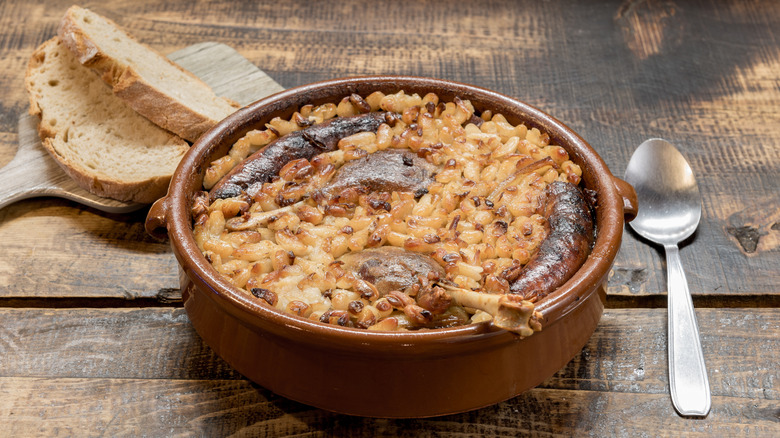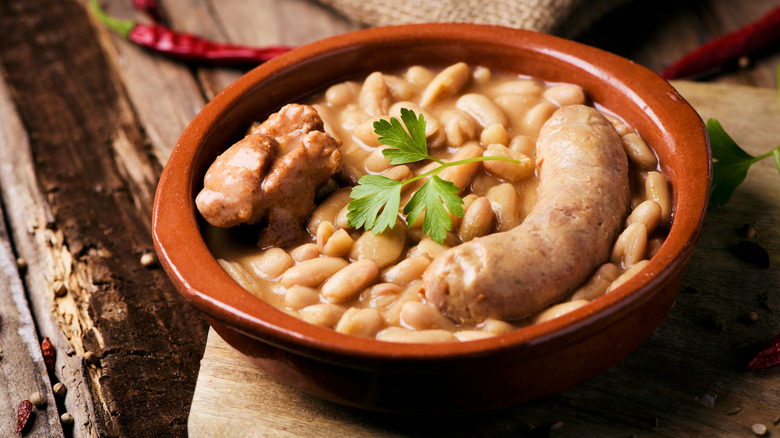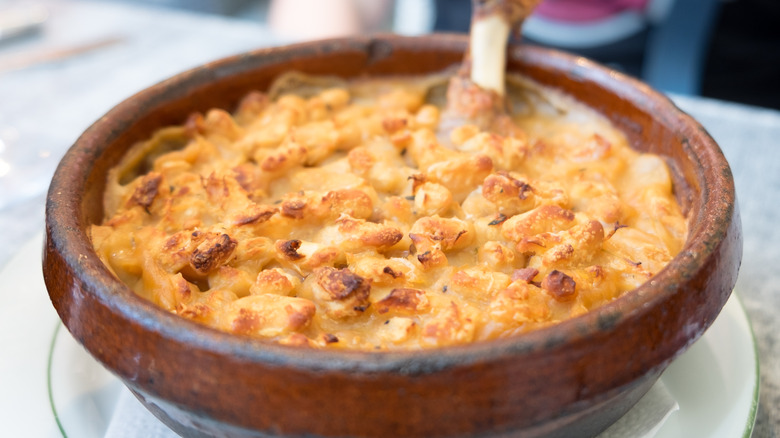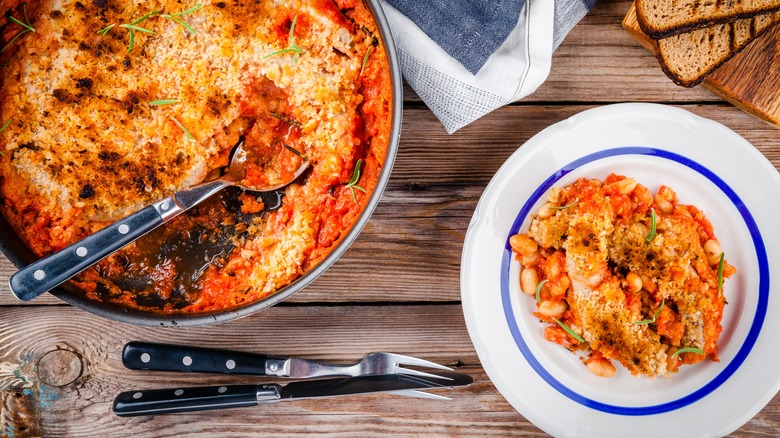The 3 Styles Of French Cassoulet, Explained
Few culinary traditions are as widely revered as that of the French, and today, we're deep-diving into one of the most iconic, sophisticated, yet pastoral dishes in the French oeuvre. Cassoulet is a rustic dish for a rustic landscape. This meat-and-beans stew is a staple of French country cooking, a stick-to-your-ribs, timeless, elevated fare perfect for when colder weather starts rolling through. Cassoulet is a slow-cooked casserole named after the vessel in which it's cooked, the "cassole," a round, deep dish with slanted sides. Cassoulet is a rich, hearty combination of meat and white beans. A variety of different proteins can be used, but duck, goose, pork sausages, and mutton are common. Pork skin (couennes) is also often used.
Cassoulet originated in and remains popular throughout Southwestern France, a region known as the Languedoc, where foodies have different recipes from one village to the next. In fact, three separate towns have asserted their own claims on the dish and subsequently inspired the cassoulet's three main variations: Castelnaudary, Carcassonne, and Toulouse. Depending on who you ask (and in which part of the Languedoc they live), what constitutes an "authentic" cassoulet can be a whole host of different things.
For such a warming comfort food, cassoulet is the subject of fierce debate. But all three of the popular styles are delicious in their own ways and worthy of celebration.
Castelnaudary
Castelnaudary cassoulet is a showcase of regional ingredients with the most straightforward flavor profile of the three cassoulet styles. It combines fried pork skins and different cuts of pork and duck, all cooked in a flavorful broth of garlic, thyme, onion, and other spices. In fact, Castelnaudary's broth is pretty much the same broth used by all cassoulet versions, boasting a flavorful bouquet of aromatics like carrot, celery, garlic, parsley, bay leaves, and cloves. After its long, slow simmer, the desired consistency ends up closer to a loose sauce than a broth. Some home cooks add gelatin to the broth as it cooks to achieve a thicker mouth feel.
Per the lore, cassoulet might have been invented in Castelnaudary during the Hundred Years' War, a dish born of necessity as immobilized civilians had to pull together filling meals with whatever ingredients they had on hand (meat scraps and beans). Modern French foodies have embraced cassoulet as both an enduring culinary phenom and a jewel of regional history, and in 1972, the region even established La Grande Confrérie du Cassoulet de Castelnaudary — a designated society in the dish's honor.
Carcassone
French cooking often gets a bad rap for being inaccessible, and as much as we'd like to argue this point, cassoulet is a pretty involved dish. Its prep is simple, but extremely time-intensive, as traditional cassoulet recipes took several days to make. The beans are soaked overnight and simmered until tender, then each piece of meat is cooked in goose fat, and the whole thing is topped with a layer of breadcrumbs before baking for several hours more. Soaking the beans in salted water overnight helps them retain their moisture during the long tenure on the stove or in the oven. But, modern foodies can cut down on prep time significantly by using pre-soaked canned beans, ideally cannellini or small navy beans.
Carcassonne cassoulets in particular are baked at a low temperature for several hours. The recipe is the most straightforward cassoulet of the trio, using some combination of pork, duck confit, goose, and partridge. Notably, geese and partridges aren't exactly easy to find in modern supermarkets, so Carcassonne cassoulet can be made more accessible to contemporary home cooks by swapping the game birds for chicken. You can find store-bought duck fat in many grocery stores or at the local butcher shop, and a spoonful of this can help emulate the classic flavor profile in one simple step. Cassoulet (especially Carcassonne style) may be a meat-lovers stew, but vegetables can totally be added into the mix too; plum tomatoes are a common addition.
Toulouse
As its namesake implies, Toulouse-style cassoulet is made with Toulouse sausage and topped with a golden crust of toasted breadcrumbs. Known locally as "saucisse de Toulouse," Toulouse sausage is a flavorful meat made from pork, wine, garlic, basil, parsley, and bacon bits. Toulouse-style cassoulet is a one-pot meal slow-simmered on the stove, making for the easiest prep of the three cassoulet styles. Other variations also include mutton, lamb, or duck confit.
In the absence of Toulouse sausage, some French foodies load up their Toulouse cassoulet with a hearty, meaty combination of ham hocks, pork skin, salt pork, duck fat, pancetta, prosciutto, duck confit, and/or pork sausages.
At the end of the day, a large, bubbling tureen of meat and beans by any name is alright in our book. Serve your hearty cassoulet with a simple Caesar side salad, roasted Brussels sprouts, or creamed corn. To best bring out its dimensional flavor, pair the meal with a tannin-forward red wine to cut through the fattiness of the pork and game birds. In the Languedoc region, cassoulet is typically paired with robust local wines like Minervois, Corbieres, and Corbieres Boutenac. For the rest of us, a Red Bordeaux fits the bill quite well. Cassoulet also reheats super well for leftovers. You could even make a cassoulet the day before a dinner party for easy hosting and serve it straight out of the cassole cooking vessel.



